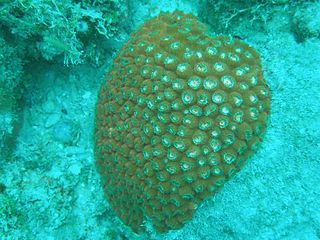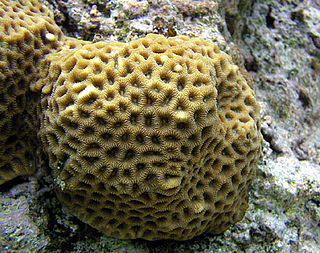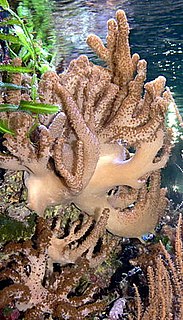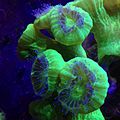
Cnidaria is a phylum under kingdom Animalia containing over 11,000 species of aquatic animals found both in freshwater and marine environments, predominantly the latter.

Corals are marine invertebrates within the class Anthozoa of the phylum Cnidaria. They typically form compact colonies of many identical individual polyps. Coral species include the important reef builders that inhabit tropical oceans and secrete calcium carbonate to form a hard skeleton.

A coral reef is an underwater ecosystem characterized by reef-building corals. Reefs are formed of colonies of coral polyps held together by calcium carbonate. Most coral reefs are built from stony corals, whose polyps cluster in groups.

The Coral Sea is a marginal sea of the South Pacific off the northeast coast of Australia, and classified as an interim Australian bioregion. The Coral Sea extends 2,000 kilometres (1,200 mi) down the Australian northeast coast. The sea was the location for the Battle of the Coral Sea, a major confrontation during World War II between the navies of the Empire of Japan, and the United States and Australia.

Anthozoa is a class of marine invertebrates which includes the sea anemones, stony corals and soft corals. Adult anthozoans are almost all attached to the seabed, while their larvae can disperse as part of the plankton. The basic unit of the adult is the polyp; this consists of a cylindrical column topped by a disc with a central mouth surrounded by tentacles. Sea anemones are mostly solitary, but the majority of corals are colonial, being formed by the budding of new polyps from an original, founding individual. Colonies are strengthened by calcium carbonate and other materials and take various massive, plate-like, bushy or leafy forms.

Coral snakes are a large group of elapid snakes that can be subdivided into two distinct groups, Old World coral snakes and New World coral snakes. There are 16 species of Old World coral snake in three genera, and over 65 recognized species of New World coral snakes in two genera. Genetic studies have found that the most basal lineages are Asian, indicating that the group originated in the Old World.

Scleractinia, also called stony corals or hard corals, are marine animals in the phylum Cnidaria that build themselves a hard skeleton. The individual animals are known as polyps and have a cylindrical body crowned by an oral disc in which a mouth is fringed with tentacles. Although some species are solitary, most are colonial. The founding polyp settles and starts to secrete calcium carbonate to protect its soft body. Solitary corals can be as much as 25 cm (10 in) across but in colonial species the polyps are usually only a few millimetres in diameter. These polyps reproduce asexually by budding, but remain attached to each other, forming a multi-polyp colony of clones with a common skeleton, which may be up to several metres in diameter or height according to species.

Montastraea is a genus of colonial stony coral found in the Caribbean seas. It is the only genus in the monotypic family Montastraeidae and contains a single species, Montastraea cavernosa, known as great star coral. It forms into massive boulders and sometimes develops into plates. Its polyps are the size of a human thumb and fully extend at night.

Brain coral is a common name given to various corals in the families Mussidae and Merulinidae, so called due to their generally spheroid shape and grooved surface which resembles a brain. Each head of coral is formed by a colony of genetically identical polyps which secrete a hard skeleton of calcium carbonate; this makes them important coral reef builders like other stony corals in the order Scleractinia. Brain corals are found in shallow warm water coral reefs in all the world's oceans. They are part of the phylum Cnidaria, in a class called Anthozoa or "flower animals". The lifespan of the largest brain corals is 900 years. Colonies can grow as large as 1.8 m (6 ft) or more in height.
Fragmentation in multicellular or colonial organisms is a form of asexual reproduction or cloning, where an organism is split into fragments. Each of these fragments develop into mature, fully grown individuals that are clones of the original organism.

Acropora is a genus of small polyp stony coral in the phylum Cnidaria. Some of its species are known as table coral, elkhorn coral, and staghorn coral. Over 149 species are described. Acropora species are some of the major reef corals responsible for building the immense calcium carbonate substructure that supports the thin living skin of a reef.

Mussidae is a family of stony coral in the order Scleractinia. Following a taxonomic revision in 2012, the family is now restricted to species found in the Atlantic Ocean, with Pacific species transferred to the new family Lobophylliidae. Many species are referred to as brain coral because their generally spheroid form and grooved surface resembles the convolutions of a brain.

Alcyonacea, or soft corals, are an order of corals. In addition to the fleshy soft corals, the order Alcyonacea now contains all species previously known as "gorgonian corals", that produce a more or less hard skeleton, though quite different from "true" corals (Scleractinia). These can be found in suborders Holaxonia, Scleraxonia, and Stolonifera. They are sessile colonial cnidarians that are found throughout the oceans of the world, especially in the deep sea, polar waters, tropics and subtropics. Common names for subsets of this order are sea fans and sea whips; others are similar to the sea pens of related order Pennatulacea. Individual tiny polyps form colonies that are normally erect, flattened, branching, and reminiscent of a fan. Others may be whiplike, bushy, or even encrusting. A colony can be several feet high and across, but only a few inches thick. They may be brightly coloured, often purple, red, or yellow. Photosynthetic gorgonians can be successfully kept in captive aquaria.

The Fungiidae are a family of Cnidaria, commonly known as mushroom corals or plate corals. The family contains thirteen extant genera. They range from solitary corals to colonial species. Some genera such as Cycloseris and Fungia are solitary organisms, Polyphyllia consists of a single organism with multiple mouths, and Ctenactis and Herpolitha might be considered as solitary organisms with multiple mouths or a colony of individuals, each with its separate mouth.

Corallimorpharia is an order of marine cnidarians closely related to stony or reef building corals (Scleractinia). They occur in both temperate and tropical climates, although they are mostly tropical. Temperate forms tend to be very robust, with wide and long columns, whereas tropical forms tend to have very short columns with a wide oral disc and very short tentacles. The tentacles are usually arranged in rows radiating from the mouth. Many species occur together in large groups, although there are recorded instances of individuals. In many respects, they resemble the stony corals, except for the absence of a stony skeleton. Morphological and molecular evidence suggests that they are very closely related to stony corals.

Colpophyllia is a genus of stony corals in the family Mussidae. It is monotypic with a single species, Colpophyllia natans, commonly known as boulder brain coral or large-grooved brain coral. It inhabits the slopes and tops of reefs, to a maximum depth of fifty metres. It is characterised by large, domed colonies, which may be up to two metres across, and by the meandering network of ridges and valleys on its surface. The ridges are usually brown with a single groove, and the valleys may be tan, green, or white and are uniform in width, typically 2 centimetres. The polyps only extend their tentacles at night.

Carpilius corallinus or batwing coral crab is a species of crab.

Merulinidae is a family of reef-building stony corals.

Diogenes heteropsammicola is a species of hermit crab discovered during samplings between 2012 and 2016 in the shallow waters of the Japanese Amami Islands. This D. heteropsammicola is strongly associated with the walking corals. This hermit crab species is unique due to the discovery that they use living, growing coral as a shell. Crustaceans of this type commonly replace their shell as the organism grows in size, but D. heteropsammicola are the first of their kind to use solitary corals as a shell form. Heteropsammia and Heterocyathus are the two solitary corals that this hermit species has been observed as occupying. These two coral species are also used as a home by symbiotic sipunculans of the genus Aspidosiphon, which normally occupy the corals that the crabs were found inhabiting.

Heteropsammia is a genus of apozooxanthellate corals that belong to the family Dendrophylliidae.























